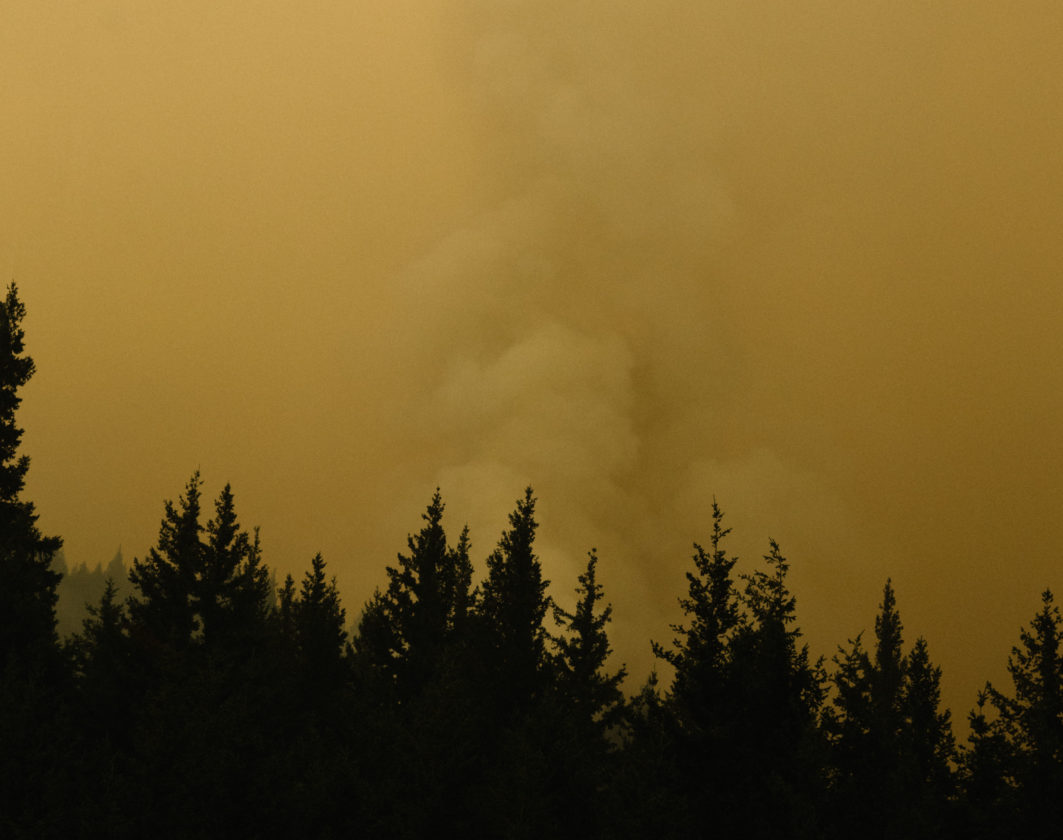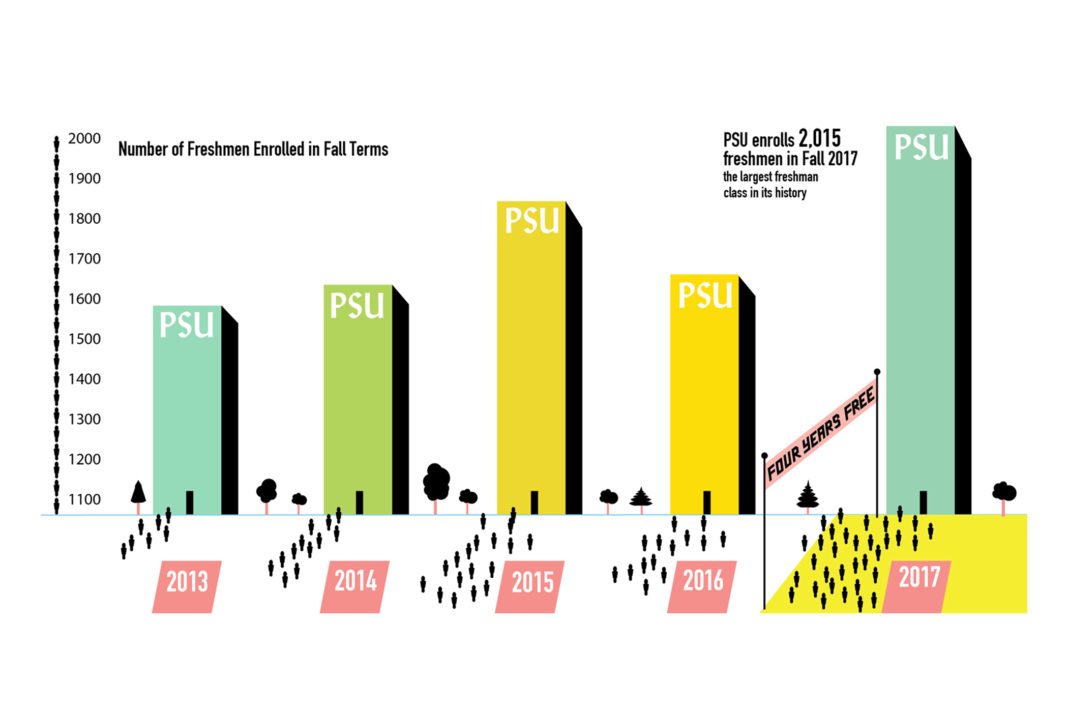The Columbia River Gorge caught fire on Sept. 2 after a group of teens allegedly lit hazardous fireworks in Eagle Creek Canyon. The fire burned for weeks and still smolders at the time of publishing this podcast. On Oct. 19, the Hood River County District Attorney’s Office announced reckless burning and other charges filed against a 15-year-old Vancouver boy for his alleged role in the fire’s reach.
Joe Michael Riedl’s podcast, Run for your life, explores the effects of the fire on Columbia River Gorge inhabitants and long-time residents and what the fire means for the future of the iconic Gorge.
Run for your Life was created and produced by Joe Michael Riedl, in partnership with PSU Vanguard, with help from Vanguard Editor-in-Chief Colleen Leary and the editorial staff.
Run for your life podcast transcript
Joe Michael Riedl: Search and Rescue came for Shelley at 3 [a.m.]. The Eagle Creek Fire was burning just a few miles away from her home in Corbett, so it wasn’t a surprise to see them walking up her driveway in the middle of the night.
Shelley Benfield: I was keeping track of it on my phone, but I was also packing because it was so much ash. It was just like when Mt. St. Helens blew. I was around when Mt. St. Helens blew, and it was the exact same feel.
JMR: She works in the wine industry and has called the Columbia River Gorge home her whole life. If you’re driving to the Vista House along the Scenic Highway, it’s hard to miss the giant peace sign that sits in her front yard. She loves where she lives, but that night she couldn’t sleep. Instead, she spent all night preparing for the inevitable evacuation order.
SB: There’s no rest. I just kept taking showers and loading stuff. But I really didn’t load that much. I got my cat, I got my pillow, got a blanket, a couple change[s] of clothes. That was it. When you’re looking around at all these things that are really important to you in your house and your life—I’ve lived there all my life—and all of a sudden I realized I just need this shirt, a pair of pants. Maybe I should take a pair of shoes. It just got down to that basic. I wasn’t loading pictures or memorabilia or any of that.
JMR: It was hard for her leave. It was the home that her great-great grandpa built. When she spoke about growing up in the [Columbia] Gorge, her words weighed heavy with love and appreciation for the untouched beauty, for the crystal clear waters that she played in, and for the miles of the trails that she hiked as a kid.
[1:45]
SB: It’s difficult. My family’s been there 140 years. I’m fourth generation Oregonian. That’s my home! It’s been my home all my life so it’s heart wrenching to think of losing a legacy that’s 140 years in my family…All that work, all those generations and all they gave to improve the land, and then just have it destroyed in a blink of an eye, it’s—well that’s what a disaster is.
JMR: I was feeling pretty blue after talking with Shelley. Ash was falling and getting into my eyes on my bike ride to the bus stop. I had to blink rapidly just to see where I was going. The smoke was so thick that I could hear my lungs wheezing with every breath. But it wasn’t just the hellish scene outside or Shelley’s story that had me so down. It was the fact that these extreme years where smoke, even ash, blankets Portland and hundreds are displaced by wildfires so close to home may become more common.
I talked with Dr. Paul Loikith, Assistant Professor of Geography and Climate Science Lab Director at Portland State earlier that day. He explained that warmer temperatures mean easier ignition in forests.
Dr. Paul Loikith: When you have a warmer atmosphere, the evaporative demand on the soils and the trees and the crops and everything that needs water goes up, so you dry out quicker, fire season could start earlier, it can last longer and be more severe.
JMR: Damn.
I had class the next day. It was the first session of three in preparation for a fieldwork course out in northeastern Oregon. The topic, appropriately, was wildfire management.
I quickly learned how complex wildfire management really is. There’s all these questions—like when we should let a fire burn or not—that have no real answer because it depends on who you ask. Take it this way: if you ask a logger, they’ll have a certain idea of how the forest should be managed. An environmentalist will have a totally different answer. And same goes for the retiree who lives in the middle of the forest. They all have different stakes in the matter.
The course was instructed by Dr. Max Nielsen-Pincus and Dr. Andres Holtz. They told us to let go of our pre-existing notions on the matter, that we shouldn’t look at wildfire as explicitly good or bad. On the news, wildfires seem pretty scary. They burn down our homes and get in the way of our lives.
[4:46] This view, which has been held by the general public for the last hundred years, has really driven the way we manage forests. When there’s a fire, we put it out, stopping it before it spreads. We suppress the fires. But that’s meant a build up of fuels, so now, when fires spark, it’s easier for them to spread and they get big quick. These tactics are widely criticized for being an unsustainable solution. You can see why when you look at the U.S. Forest Service Budget Report: In the 90s, 16 percent of funds were allocated to wildland fires. A couple years ago, it was more than 50 percent. By 2025, wildland fires are expected to consume nearly 70 percent of the U.S. Forest Service Budget.
[5:27] But the way we deal with wildfires is beginning to change. Scientists have known it for a long time, but the general public is just coming around to the realization that forests need fire.
A good example of change in management is prescribed burning. It’s when we go in and start the fires ourselves to clear out built-up brush. This tactic is common in ponderosa-pine forests like those on the east side of the Cascades. Those forests are highly adapted to fire. Wildfires are so frequent, in fact, that there’s hardly any ladder fuels—a term applied to understory brush that offers a ladder for the fire to climb to the crown.
Instead, you’ll mostly see grasses in these forests, so when fires spark, they burn through quickly, and hardly damage the bigger trees. When we go in and put out fires, we’re taking away the disturbance that a forest needs to be healthy. The Intermediate Disturbance Hypothesis proposes that maximum diversity within an ecosystem occurs when disturbance like fire is neither too rare, nor too frequent, but somewhere in the middle. Ecosystems need disturbance to thrive.
But that’s not all wildfires do for forests. They take the decaying matter on the ground and put the nutrients back into the soil. They clear out invasive species and open up space for new plants. They can eliminate disease and noxious insects. Newly dead trees offer homes for cavity-nesting creatures. And, my personal favorite, after fires wildflowers bloom like crazy. That’s the answer I got from Dr. Nielsen Pincus when I asked about a silver-lining to the Eagle Creek fire. “I think next spring is going to be a great year for wildflowers in the Gorge. Some of those stands that burned with a little more intensity or higher-severity fire that went through them, there’s gonna be a lot of light hitting the soil. It’s going to really change the dynamic of what grows in those forests.
So wildflowers and other grasses, shrubby plants—those types of things—presumably we’ll find a lot of those next year. If you like wildflowers next year could be a good year to go hiking in there. One of the things that I think is interesting is just this sort of diversity of forest that we’re gonna see in there now. We’re all used to having a green carpet of forest that goes from one end of the Gorge to the other interspersed with a few rocky outcrops. Well, it’s gonna look different but there’ll be more diversity—more meadows, more hardwoods, more shrubs, and other things coming up.”
All this new information made me feel better about wildfires, like they weren’t the catastrophe that they’ve always been made out to be. But even with all this in mind, it was still hard for me to think about the Gorge and not be sad. It’s the feeling I get when I think about the house I grew up in or lost family memories. I figured the only way to feel better, or maybe just get some closure, was to go and experience it for myself.
[8:25] I drove to the Gorge on a foggy Monday morning, about a month after the fire first broke out. My first stop was one of my favorite spots: Larch Mountain. It’s one of the highest points in the Gorge. I thought it would offer a good view of the damage. It had just rained but the clouds cleared. Big drops of water fell from droopy maple leaves and onto the street. Steam rose from the ground and up toward the tall fir trees that enveloped the road. It felt like the same old Gorge—wet and cozy. I wanted to hop out and explore.
[8:57] This place hadn’t changed. It wasn’t a portion that the fire swept through, so I was surprised when I came to a road block. I had to turn around and head back to the highway.
I got on I-84 and headed east. I could see waterfalls still flowing, green still everywhere, but with more rocky-outcrops, more dead trees, more open spaces. I looked to the freshly burned, toothpick-lined peaks and imagined the view from them; god, it must be beautiful. I couldn’t wait to explore, couldn’t wait to see all the changes, but every exit was the same: road closed. Public access blocked. And they were all closely guarded by folks in orange vests, presumably stationed there 24/7. Maybe just a little bit further, I kept telling myself. Eventually I pulled off and up to one of the orange vested-attendant to see where I could access the trails.
[9:30 recording of conversation between JMR and safety attendant on location in the Gorge]
JMR: How’s it going? Are there any waterfalls around here open to the public?
Safety Attendant: No. All closed due to the wildfire. And your safety. You can go to Silver Creek Falls in Silverton. That’s the only closest falls that I know of.
JMR: So is it pretty dangerous in there
SA: Yeah.
JMR: And there’s literally no public access?
SA: “No public access whatsoever.”
JMR: How long will that be?
SA: Probably not until March. That long.
JMR: Really? It’s that bad?
SA: Until [Oregon Department of Forestry] says, we have our hands tied.
[10:29]
JMR: March? You mean to tell me that the Gorge is going to be shut down during rainy season? The best season to hike it? Ah man. So that’s it. I didn’t get to see it. No closure, just a waiting game. But I can’t wait. I want to see it, explore its new pockets, see if the waterways have changed, hike through portions that have burnt to a crisp. But I have to wait. And while I do, my anticipation to get back in there, to hike those trails, is growing.
Afterword: [11:08]
JMR: I caught up with Shelley over the phone not too long ago. She had been back in her home for a few weeks. There was a ton of ash, but, for the most part, she found it the way she left it. The peace sign was still standing. But it was strange for her to come home. She told me that she was mentally prepared to come back to a pile of burnt rubble. Luckily, she didn’t. She returned and tried to get back to her normal life, which, for her, was actually difficult.
Editor’s Note: This transcript is minimally edited for AP style and flow.









